A block X of mass 0.5 kg is held by a long massless string on a frictionless inclined plane of inclination 30∘ to the horizontal. The string is wound on a uniform solid cylindrical drum Y of mass 2kg and of radius 0.2 and of radius 0.2 m as shown in Fingure. The drum is given an initial angular velocity such that the block X starts moving up the plane.
(i) Find the tension in the string during the motion.
(ii) At a certain instant of time the magnitude of the angular velocity of Y s 10rads−1 calculate the distance travelled by X from that instant of time until it comes to rest

a. i. First Method: "Force/ Torque" Method:
Force equation for the block are as follows:
N−5cos30∘=0………..i
5sin30∘−T=0.5×a…………..ii
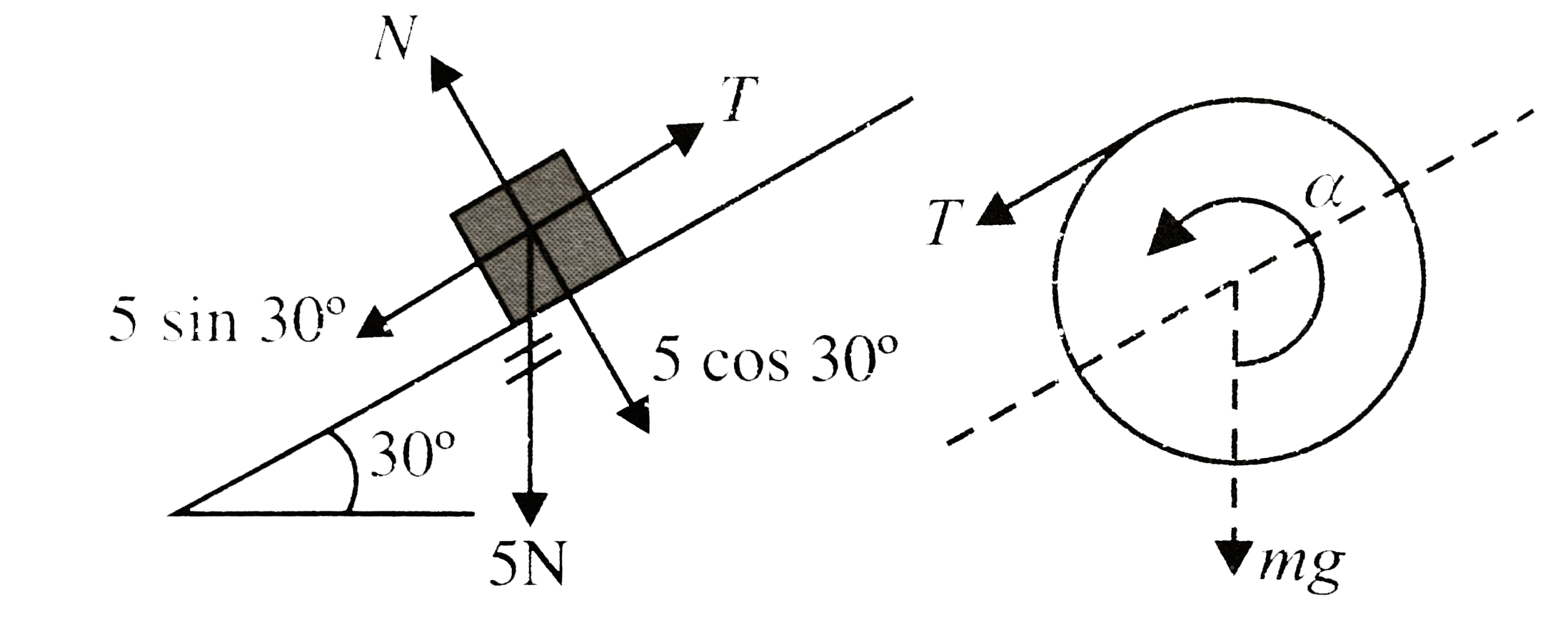
Torque equatioin for the drum
TR=(12MR2)α
⇒T=12MRα=12×2×0.2α⇒t=0.2α..........iii
Here a=Rα (The string does not slip on the drum)
Thus T=(0.2)(aR)=0.2(a0.2)=1×a .......i
From eqn ii and iv we get
a=53ms,T=53N
ii. Second Method: Using the equation →τ=−→dLdt
Take both block X and drum Y as a system.
Torque acting on the system about the centre of mass of the drum =(mgsin30∘)R, anticlockwise . Angular momentum of the system about the centre of mass of the drum,
L=mvR+12MR2ω
=m(rω)R+12MR2ω
=(mR2+12MR2)ω, clockwise
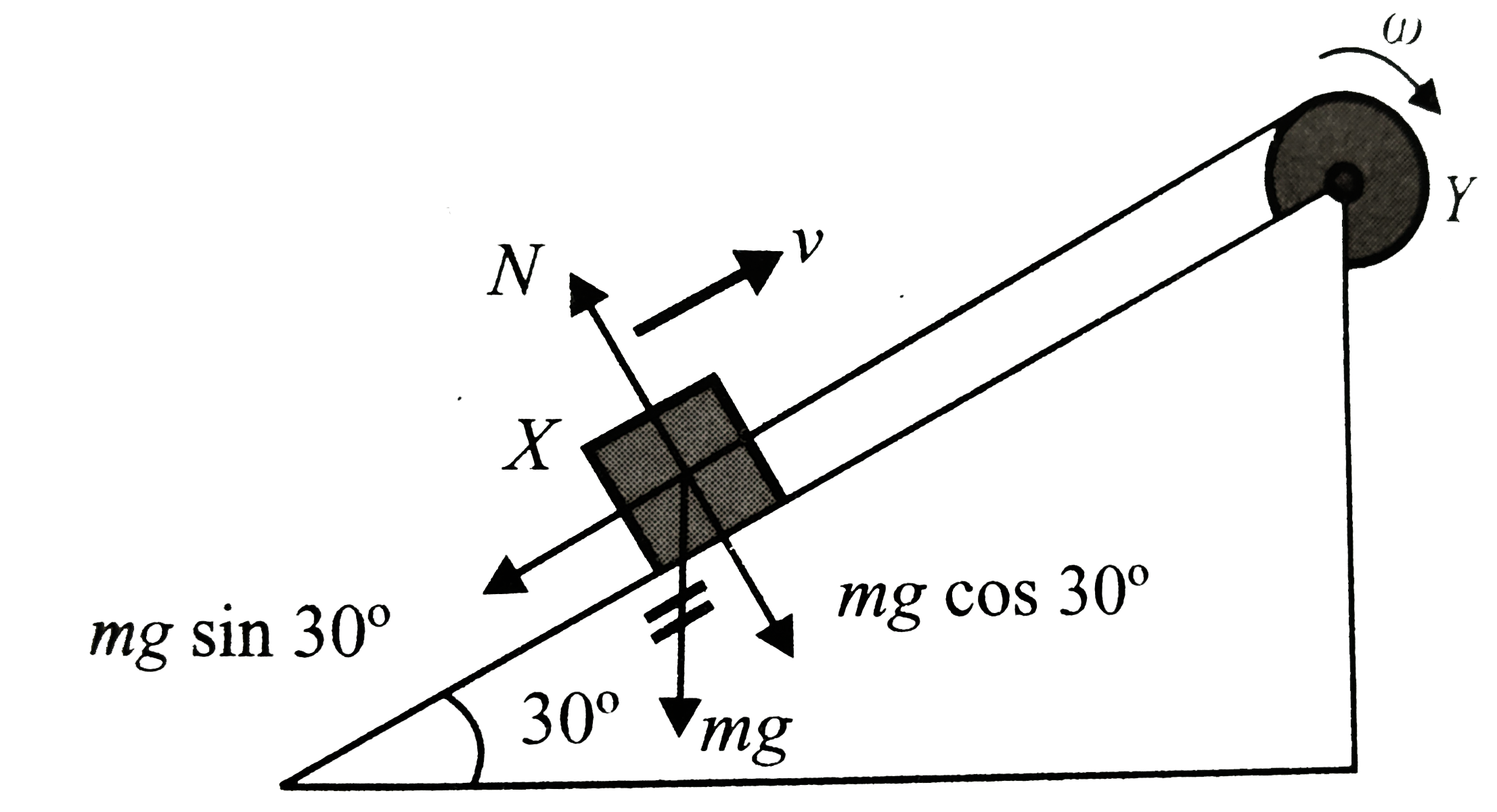
Apply equation →τ=−→dLdt
−mgRsin30∘=ddt(mR2ω+12MR2ω)
=(mR2+12MR2)dωdt
⇒dωdt=−mgRsin30∘(mR2+MR22)
⇒(dωdt)aniticlockwise
=mgRsin30∘(mR2+MR22)
(ω has been taken in the clockwise sennse dωdt is negative.
So, dωdt is in the anticlockwise sense).
clearly, τ=IαTR=I(dωdt)anticlock
=(12MR2)⎛⎝mgRsin30∘m+M2⎞⎠=53N
b. i. First method:
Angular velocity of Y=10rad/s
Velocity fo block X=Rω=0.2×10=2m/s, along the plane upwards
Acceleration of X=53ms2 along the plane downwards
Using equation v2=u2−2as,
02=(2)−2×53×s⇒s=4×32×5=1.25m
ii Second Method:
You can also calculate the distance X moves upwards from the energy considerations
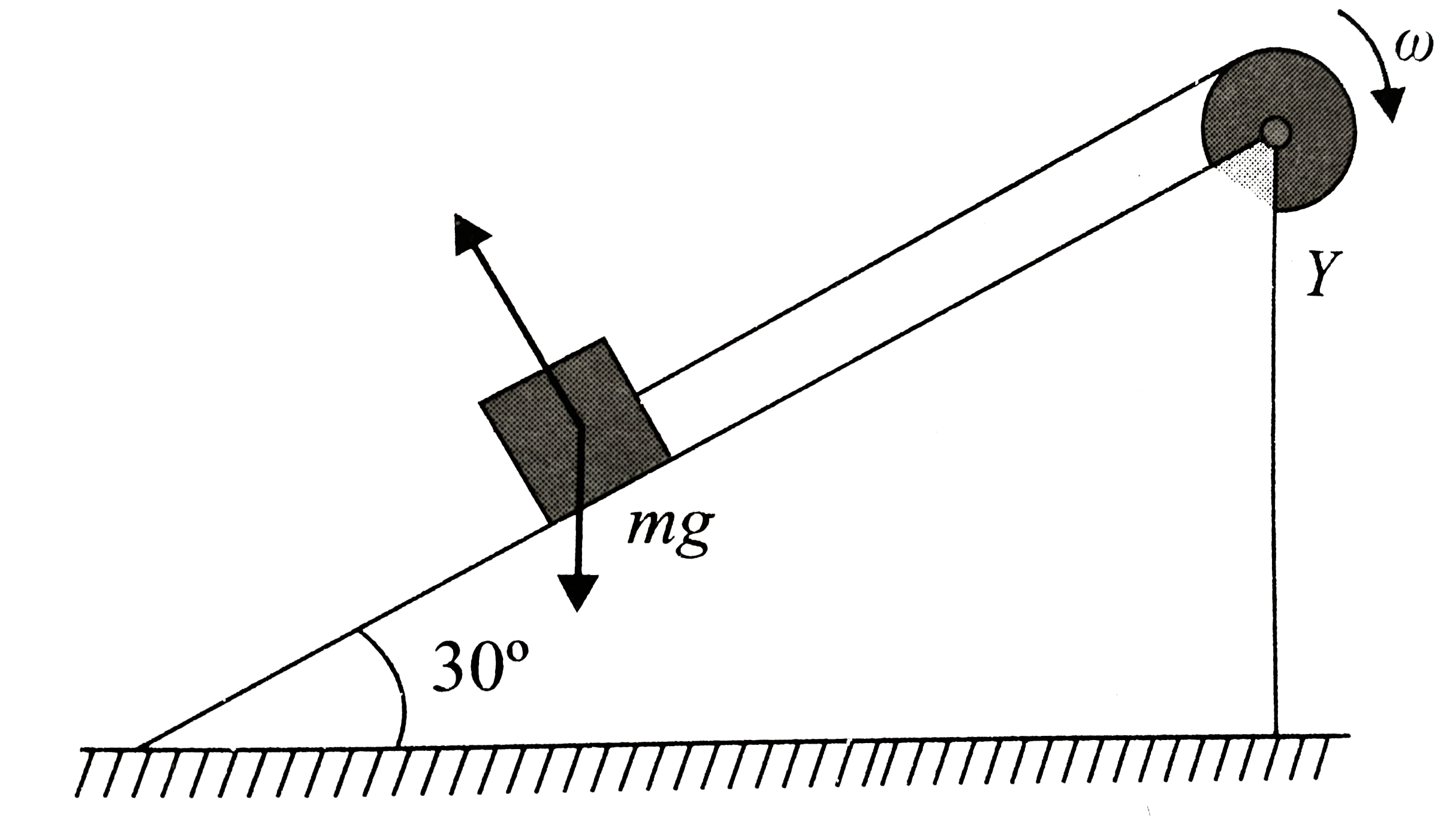
WN+Wmg+Wf+Wmg=K2−K1
0−(mgsinθ)s+0+0=(12mv2+12IΩ2)
⇒(mgsinθ)s=12mv2+12Iω2
∴s=mv2+Iω22mgsinθs
=(0.5)(2)2+2×2×(0.2)2×(10)22x0.5×10×12=1.2m
iii. Third Method: By Mechanical Energy Conservation
Here the only force which does work on the system mg, the algebraic work done by other forces is zeros, is conservative in nature, therefore, the mechanical energy of the system will remain constant. Let the distance moved by the block X along the plane be s.
Gain in gravitational potential energy of X=mgssinθ.
Loss in kinetic energy of the block and the drum is
12mv20+12Iω20(v0=ω0r)
Thus, mgssinθ=12mv20+12Iω20
s=mv20+Iω202mgsiθ
After substituting the given values s=1.02m
Topper's Solved these Questions
- RIGID BODY DYNAMICS 2Book:CENGAGE PHYSICSChapter:RIGID BODY DYNAMICS 2Exercise:Exercise 3.1
Explore 11 Videos
- RIGID BODY DYNAMICS 2Book:CENGAGE PHYSICSChapter:RIGID BODY DYNAMICS 2Exercise:Exercise 3.2
Explore 13 Videos
- RIGID BODY DYNAMICS 2Book:CENGAGE PHYSICSChapter:RIGID BODY DYNAMICS 2Exercise:Interger
Explore 2 Videos
- RIGID BODY DYNAMICS 1Book:CENGAGE PHYSICSChapter:RIGID BODY DYNAMICS 1Exercise:Integer
Explore 11 Videos
- SOUND WAVES AND DOPPLER EFFECTBook:CENGAGE PHYSICSChapter:SOUND WAVES AND DOPPLER EFFECTExercise:Integer
Explore 16 Videos
Similar Questions
A block of mass 10 kg is kept on a fixed rough (μ=0.8) inclined plane of angle of inclination 30∘. The frictional force acting on the block is
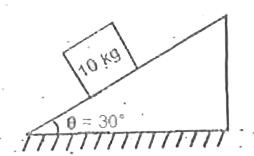
View SolutionA block of mass 5 kg is at rest on a rough inclined surface. If angle of inclination of plane is 60∘, then force applied by it on block is
View Solution
Knowledge Check
A block of mass 10kg is pushed up on a smooth incline plane of inclination 30∘, so that it has acceleration 2m/s2. The applied force is
A50 NB60 NC70 ND80 NA person pushes a block of mass 4 kg up a frictionless inclined plane 10 m long and that makes an angle of 30∘ with the horizontal . Then the work done is
A33.5JB−392JC339.4JD−196JA block of mass m is placed on a smooth inclined plane of inclination θ with the horizontal. The force exerted by the plane on the block has a magnitude
AmgBmgcosθCmgcosθDmgtanθ
A ring of mass 1kg and radius 1m is moving with a velocity of 1m/s by rolling on a frictionless inclined plane. The total kinetic energy of the ring is
View SolutionA block of mass 10 kg rests on a rough inclined plane of inclination 45∘ with the horizontal. What minimum force is required to just move the block up the inclined plane. Given μs=0.5andg=10ms−2.
View SolutionA block of mass 4 kg is pulled along a smooth inclined plane of inclination 30∘ with constant velocity 3 m/s as shown, power delivered by the force is
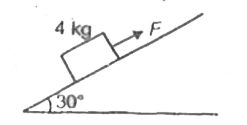
View SolutionA block of mass 10 kg is placed on an inclined plane when the angle of inclination is 30∘. The block just begins to slide down the plane. The force of static friction is
View SolutionA block of mass m is released from a height R on the frictionless incline as shown. The incline leads to a circle of radius R/2. The maximum height attained by the block is
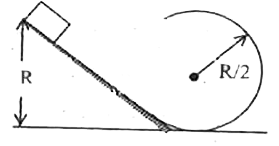
View Solution
